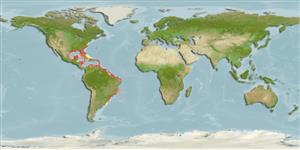Common names from other countries
Classification / Names / Names
Noms communs | Synonymes | Catalog of Fishes (gen., sp.) | ITIS | CoL | WoRMS
Environment: milieu / climate zone / depth range / distribution range
Écologie
; profondeur 1 - 130 m (Ref. 96392). Tropical
Western Atlantic: Caribbean Sea to southern Brazil. Tropical to subtropical.
Length at first maturity / Taille / Poids / Âge
Maturity: Lm ? range ? - ? cm
Feeds primarily on gastropods, bivalves and small crustaceans, and sometimes on amphipods, isopods, crabs, smaller echinoderms and fish larvae (Ref. 96392).
Life cycle and mating behavior
Maturité | Reproduction | Frai | Œufs | Fécondité | Larves
Members of the class Asteroidea exhibit both asexual (regeneration and clonal) and sexual (gonochoric) means of reproduction. Life cycle: Embryos hatch into planktonic larvae and later metamorphose into pentamorous juveniles which develop into young sea stars with stubby arms.
Alvarado, J.J. and J. Cortés. 2009. (Ref. 83942)
Statut dans la liste rouge de l'IUCN (Ref. 130435)
statut CITES (Ref. 108899)
Not Evaluated
Not Evaluated
Menace pour l'homme
Harmless
Utilisations par l'homme
| FishSource |
Outils
Plus d'informations
Taille/ÂgeCroissanceLongueur-poidsLongueur-longueurMorphologieLarvesAbondance
Sources Internet
Estimates based on models
Preferred temperature
(Ref.
115969): 21.4 - 27.7, mean 24.7 (based on 498 cells).
